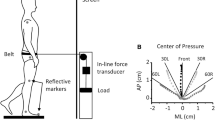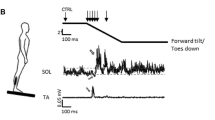Abstract
During low-frequency (<1.5 Hz) voluntary oscillations of the foot, placed on a rotating platform, onset of the Tibialis Anterior (TA) EMG paradoxically phase-lags the onset of dorsiflexion, suggesting that initial dorsiflexion is sustained by recoil of elastic structures that were stretched during plantarflexion. It is argued that the lag would disappear if the EMG onset were referred to the foot passive equilibrium position rather than to the movement onset. This hypothesis was tested in ten subjects who, after assessment of foot equilibrium position, voluntarily oscillated their foot at various frequencies (0.2–3 Hz) over three angular ranges: a mid range (foot crossing the equilibrium symmetrically), a high range (whole excursion above equilibrium) and a low range (whole excursion below equilibrium). In the mid range, phase relations were measured between the crossing of equilibrium position and the onset of the TA EMG during dorsiflexion or the onset of Soleus EMG during plantarflexion. In both cases, the paradoxical lag of EMG on movement was absent, phase curves started around zero and could be well fitted by a second order model. Phase curves with similar features were also obtained in the high and low ranges (no crossing of equilibrium) but correlating the onset of the EMG burst to the onset of the related movement. Altogether, these findings show that in all ranges of the joint excursion, the homology is between the EMG onset and the moment when the foot draws away from equilibrium. Based on the observed pattern of muscular activation, we suggest that voluntary foot oscillation in any movement range is sustained by one sinusoidal central command that, when equilibrium is crossed, is clipped in two half-waves reciprocally distributed to the couple of antagonist muscles. A simple neural circuit for this operation is proposed.




Similar content being viewed by others
References
Baldissera F, Cavallari P (2001) Neural compensation for mechanical loading of the hand during coupled oscillations of the hand and foot. Exp Brain Res 139:18–29
Baldissera F, Cavallari P, Civaschi P (1982) Preferential coupling between voluntary movements of ipsilateral limbs. Neurosci Lett 34:95–100
Baldissera F, Cavallari P, Marini G, Tassone G (1991) Differential control of in-phase and anti-phase coupling of rhythmic movements of ipsilateral hand and foot. Exp Brain Res 83:375–380
Baldissera F, Borroni P, Cavallari P (2000) Neural compensation for mechanical differences between hand and foot during coupled oscillations of the two segments. Exp Brain Res 133:165–177
Bobet J, Stein RB, Oguztöreli MN (1990) Mechanisms relating force and high-frequency stiffness in skeletal muscle. J Biomech 23[Suppl 1]: 13–21
Butler EG, Horne MK, Hawkins NJ (1992) The activity of monkey thalamic and motor cortical neurones in a skilled, ballistic movement. J Physiol 445:25–48
Butler EG, Finkelstein DI, Harvey MC, Churchward PR, Forlano LM, Horne MK (1996) The relationship between monkey ventrolateral thalamic nucleus activity and kinematic parameters of wrist movement. Brain Res 736:146–159
Carson RG (1993) Manual asymmetries: old problems and new directions. Hum Mov Sci 12:479–506
Carson RG, Goodman D, Kelso JAS, Elliott D (1995) Phase transitions and critical fluctuations in rhythmic coordination of ipsilateral hand and foot. J Mot Behav 27:211–224
Carson RG, Riek S, Smethurst CJ, Parraga JF, Byblow WD (2000) Neuromuscular-skeletal constraints upon the dynamics of unimanual and bimanual coordination. Exp Brain Res 131:196–214
Cheney PD, Fetz EE (1980) Functional classes of primate corticomotoneuronal cells and their relation to active force. J Neurophysiol 44:773–791
Cheney PD, Kasser R, Holsapple J (1982) Reciprocal effect of single corticomotoneuronal cells on wrist extensor and flexor muscle activity in the primate. Brain Res 247:164–168
Christopoulos A (1998) Assessing the distribution of parameters in models of ligand-receptors interaction: to log or not to log. Trends Pharmacol Sci 19:351–357
Fetz EE, Perlmutter SI, Prut Y, Seki K, Votaw S (2002) Roles of primate spinal interneurones in preparation and execution of voluntary hand movement. Brain Res Rev 40:53–65
Hunter IW, Kearney RE (1982) Dynamics of human ankle stiffness: variation with men ankle torque. J Biomech 15:747–752
Jeka JJ, Kelso JAS (1995) Manipulating symmetry in the coordination dynamics of human movement. J Exp Psychol Hum Percept Perform 21:360–374
Kelso JAS (1984) Phase transitions and critical behaviour in human bimanual coordination. Am J Physiol 246:R1000–R1004
Kelso JAS, Jeka JJ (1992) Symmetry breaking dynamics of human inter-limb coordination. J Exp Psychol Hum Percept Perform 18:645–668
Lakie M, Walsh EG, Wright GW (1984) Resonance at the wrist demonstrated by the use of a torque motor: an instrumental analysis of muscle tone in man. J Physiol 353:265–285
Lehman SL, Calhoun BM (1990) An identified model for human wrist movements. Exp Brain Res 81:199–208
Levin MF, Dimov M (1997) Spatial zones for muscle coactivation and the control of postural stability. Brain Res 757:43–59
Maier MA, Perlmutter SI, Fetz EE (1998) Response patterns and force relations of monkey spinal interneurons during active wrist movement. J Neurophysiol 80:2495–2513
Mewes K, Cheney PD (1994) Primate rubromotoneuronal cells: parametric relations and contribution to wrist movement. J Neurophysiol 72:14–30
Motulsky H (1999) Analyzing data with the GraphPad Prism. GraphPad Software, San Diego
Perlmutter SI, Maier MA, Fetz EE (1998) Activity of spinal interneurons and their effects on forearm muscles during voluntary wrist movements in the monkey. J Neurophysiol 80:2475–2494
Serrien DJ, Swinnen SP (1998) Load compensation during homologous and non-homologous coordination. Exp Brain Res 121:223–229
Stark LS (1968) Neurological control systems. Studies in Bioengineering. Plenum Press, New York
Stiles RN (1983) Lightly damped hand oscillations: acceleration-related feedback and system damping. J Neurophysiol 50:327–343
Swinnen SP, Dounskaia N, Verschueren S, Serrien DJ, Daelman A (1995) Relative phase destabilization during inter-limb coordination: the disruptive role of kinesthetic afferences induced by passive movement. Exp Brain Res 105:439–454
Viviani P, Soechting JF, Terzuolo CA (1976) Influence of mechanical properties of the relation between EMG activity and torque. J Physiol (Paris) 72:45–58
Weiss PL, Kearney RE, Hunter IW (1986a) Position dependence of ankle joint dynamics—I. Passive mechanics. J Biomech 19:727–735
Weiss PL, Kearney RE, Hunter IW (1986b) Position dependence of ankle joint dynamics—II. Active mechanics. J Biomech 19:737–751
Acknowledgements
This study was supported by the “Ministero della Università e della Ricerca” and the “Università degli Studi di Milano”. We are indebted to Eberhard Fetz for helpful comments and suggestions on the manuscript.
Author information
Authors and Affiliations
Corresponding author
Rights and permissions
About this article
Cite this article
Baldissera, F., Cavallari, P. & Esposti, R. Foot equilibrium position controls partition of voluntary command to antagonists during foot oscillations. Exp Brain Res 155, 274–282 (2004). https://doi.org/10.1007/s00221-003-1723-y
Received:
Accepted:
Published:
Issue Date:
DOI: https://doi.org/10.1007/s00221-003-1723-y




